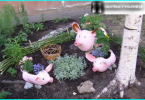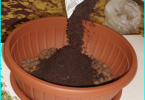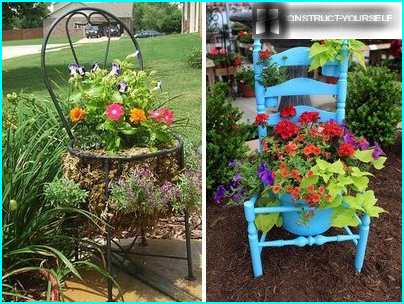
If you are on the site got the bad land, where nothing wants to grow, get her enrichment. To bring the black soil is easiest, but that’s to get it is not always possible, especially in urban areas. To make abundantly chemistry also profitable: in the end, you yourself will consume. One thing remains: to make fertile soil itself. Or rather, to learn how to cook healthy compost. It is only ignorant people are afraid to compost pits, as I think they emit a stench that taints the air throughout the area. In fact, compost does not smell if it is correctly lay and maintain the activity of the bacteria. As we will understand more.
The contents
A place for the compost pit and its arrangement
So, first pick on the site a convenient place for the compost pit. As a rule, she is offered a territory in the backyard garden, in the outbuildings, where the appearance of the waste pile will not spoil the General landscape. The only caveat: look during heavy rains where water flows. She must not run in the direction of the well (if one exists), otherwise there may be product waste, which will affect the quality and taste of the water..
Variants of arrangement of the two: you can dig a deep hole and in it lay the raw materials for compost, or to knock out the wooden boards of a wide drawer with a removable wall for convenience.
Technology of creation of the pit
A deep pit the fact that all plant material will hide in the ground and will not cut the eye, but the compost is cooked in it longer and stir it more difficult. If you are looking only this option, make a hole properly, because the normal decomposition of organic matter requires oxygen and ventilation. And the thick earthen walls and bottom no air will not pass. So dig the hole as follows:
- The soil is removed not more than a meter deep, three meters in length and a half in width.
- From the walls of the pits are retreating at 20 cm on each side, and knocked a wooden box, wcopa in the corners of the column 4 and them beat the boards.
- Between the plates a distance of about 5 cm to ventilated all the layers compost.
- Divide the pit into two equal parts using a wooden shield to fill only one half.
- The bottom throw thick branches of the trees, bark, twigs and straw (what you find). It will be a drain, diverting the excess moisture and helps the compost to aerate from the bottom. The height of the drainage layer with 10-15 cm.
Vegetable waste is stored in one part of the compost pit, but this season they are thrown several times from one half to another, to satisfy a bunch of oxygen.
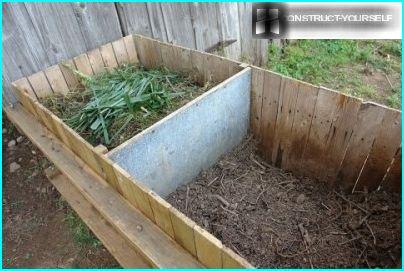
A pit you can do half in the ground, not to bury completely, then it will be easier to stir the contents and improve
The manufacturer of the compost bin
The second option of laying the compost, in a box of unpainted wood (or plastic from the factory). In appearance it is absolutely identical to the normal boxes, only several times larger. When you create a frame you don’t forget to leave a gap between the planks and one side removable to make, to make it easier to lay and mix raw materials. Alternatively, you can hang the door.
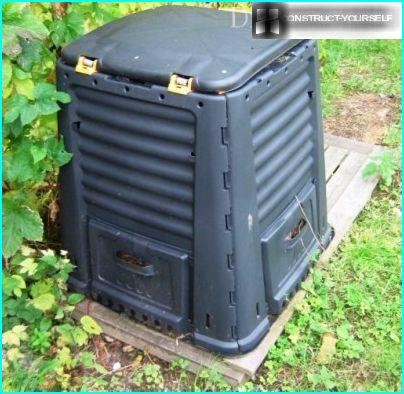
Plastic composter has a bottom perforated doors on each side, through which ventilated content, but the wet waste will have
As usual such constructions are made for many years, the floor can be concreted, and on top lay the drainage (such as in the pit). Some owners put on the bottom of the wooden or plastic shields. However, eventually the tree will become worthless, but nothing eternal does not happen.
Now we have to fill the place prepared proper raw materials that will decompose into high quality compost.
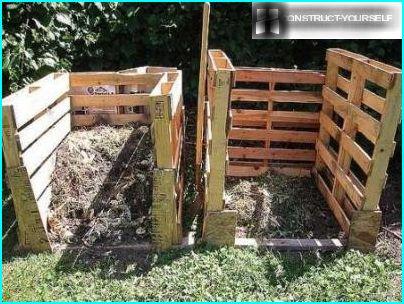
Two located near the composting bin is convenient because you can throw the waste to air from one to the other, while not clogging up the surrounding area
Features the correct landfill
Useful raw materials
To your pile successfully and rotting during the new season, turned into fertile soil, it is necessary to throw in the compost only plant waste: leaves, grass clippings, remains of roots and fruits, turf, weeds, finely chopped branches of trees and shrubs.
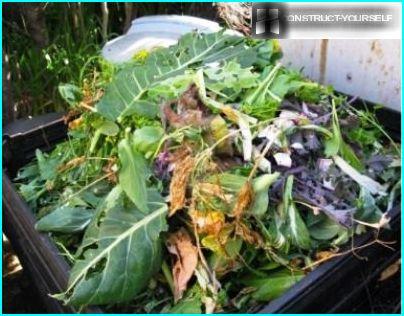
Laying in a compost pit waste from the garden, you thereby solve the problem of removal of plant debris and get fresh, quality ground
To make the composition of the compost even more nutritious put into it everything that didn’t eat themselves: leftovers, soups, coffee grounds, tea leaves, yesterday’s salad, etc. in a word, put in the house next to the garbage can one more container for plant waste, and you will be surprised how quickly it will fill up. Suitable for compost used cardboard boxes, Newspapers (black and white), worn-out things from natural materials (cotton, wool).
Unwanted ingredients
Now focus on the harmful, from the point of view of experienced gardeners, waste. Categorically be put in the compost residues products of animal origin: dead birds and animals, old fat, fats, intestines, spoiled milk, sour cream, etc. All that the decomposition begins to exude an unpleasant odor and will attract to a lot of harmful insects, neighborhood dogs, cats and crows. Besides, putrefactive processes in animal remains slower than in the plant, and your compost will not have time to ripen for the next season.
But to marine wildlife gardeners and undecided. One of them is not added, so as not to attract animals to the pile, but others are happy to throw in the compost pile, all that remains is to clean the fish (head, scales, guts), citing the fact that they contain valuable for plants phosphorus. Just have the waste buried deeper in the pile for scent doesn’t smell cats.
Indeed, fish feeding useful. So, everybody who is a pity to throw away a valuable product, I advise you: do not put them in the compost and bury under the trees, in the unloading circles. Only dig the hole deeper. So you and the garden will feed and stray animals will not attract.
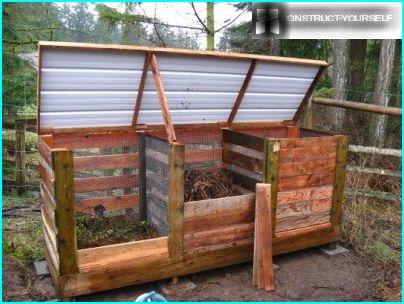
If you get knocked down compost box with an opening roof, then feel free to put inside the fish waste, in such capacity, the animals will not get through
Can not be put in a pit of plastic, glass, metal objects, rubber, water from washings etc They harmful to the soil. No benefit and all paper products on the basis of laminated or colored drawings. Too much paint and chemicals there is.
Unwanted ingredient in compost is tops of tomatoes and potatoes. In the autumn it’s all affected by late blight, and the spores of this disease will be passed from compost to healthy plants.
Do not lay compost and weeds with the beginning or ending flowering period. For example, if the dandelion had time to shape the flower, the seeds still ripen, even if it is broken and placed in a heap. So try to mow the weeds before the appearance of flower buds.
If you have nowhere to put the tops Solanaceae and large weeds, which managed to oltenitsa, – lay them on a solid base (concrete, linoleum) near the compost pit and allow to dry. Then throw all the vegetation in an iron barrel and ignite. All burn, together with the diseases and seeds. Stay healthy ash. It and put it in your compost pile.
How to lay waste to the compost?
To waste decayed quickly, you need moisture, oxygen boosters and putrefaction. Moisture is pouring abundantly a lot in the periods when the street is hot. Oxygen to penetrate the compost active, if you correctly place the layers of materials. Thus, the dry waste (potato peels, straw, hay, leaves, husks, etc.) should be alternated with green (leaves, grass, decaying vegetables and fruits), soft with hard, to avoid over-compaction. It is very important that a compost is prepared of brown and green components identified in equal shares. Fresh waste is the main source of nitrogen necessary to all plants. Brown (ie dry) perform the role of a layer, not giving the compost to stick together. They are considered a kind of fiber, which makes the soil lighter and easier.
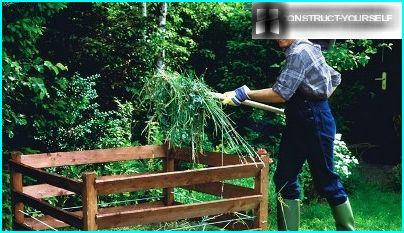
Try to put green and brown waste in equal proportions, as an excess of green will lead to compaction, and excess of dry raw materials are sucked from compost nitrogen
If you need compost by next spring – add the accelerators of the decomposition process. It can be bought in a garden shop concentrates that must be diluted with warm water and activate the work of beneficial bacteria contained in the product.
An accelerator is a fresh manure (horse or cow). On the field, find a couple of pellets, throw them in a bucket of water and give a day or two to infuse. Then the ready solution is poured into the compost and mix the contents of the heap. If this stuff near your house no – finely chop the dandelion leaves, nettle, legumes, pour bucket of warm water and leave it in the sun. Through day 4 the mixture will begin to ferment. Then pour it on the compost heap.
To avoid the weathering of nitrogen, compost pile on top of it is a nonwoven material or film black. Closed decay is faster, and a symptom of this is active heat. Inside the compost temperature should be at least 60 degrees.
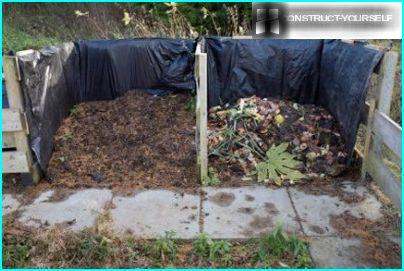
Cover with film, wooden box from top to bottom are highly undesirable, because by doing so you block the path of oxygen and the quality of the finished compost will be much worse
For the season, a heap shoveled 3-4 times to ensure uniform decay of all layers. The spring vegetable waste turn into rich, loose soil with the smell of the earth that can be deposited under trees to mulch the strawberries or mix with garden ground to improve its structure.


